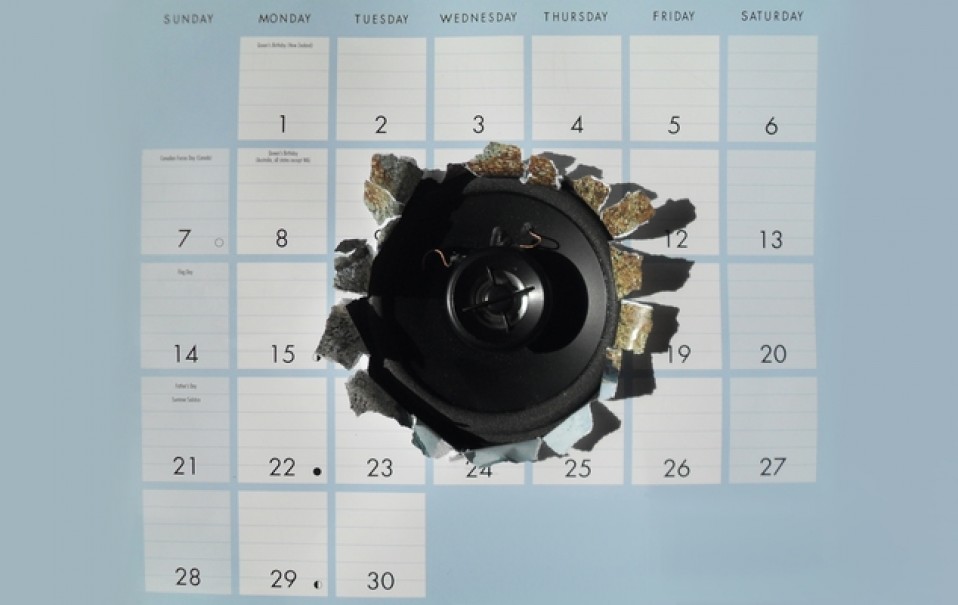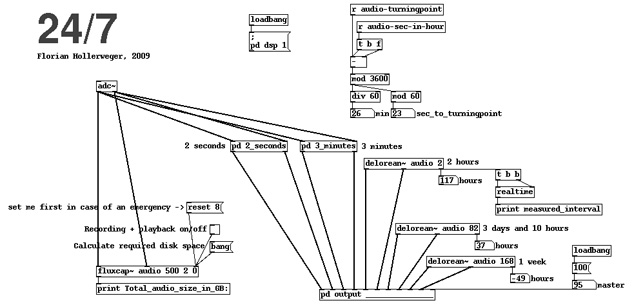
Work phase
05-14 October
Exhibition phase
15- 24 October
Opening
Thursday 15 October, 6-8pm
Opening hours
Tues- Sat 1-5pm
24/7
Florian Hollerweger
Ends 24 October 2009
The structures of the everyday manifest themselves through sound, whether we register it consciously, subconsciously, or not at all. We live our lives rhythmically, and as we do, we always create sound. In a complex social interplay the polyrhythms of our everyday lives involuntarily leave their traces in the soundscape. Church bells ring every hour. Traffic becomes quieter during the night. Radio programs repeat themselves weekly. Christmas carols are sung during a certain time of the year (except maybe in shopping malls). Since these everyday rhythms mostly unfold themselves on time scales which exceed our short-term `performative' memory, we are not used to experience them aesthetically.
`24/7' by Florian Hollerweger sets up a frame for you to do exactly that. Two weeks of sound are continuously being recorded at PS². Visitors are invited to tune into earlier stages of the recording, listening to the gallery space as it sounded minutes ago, hours ago, days ago, or a week ago.
By comparing what the gallery space sounded like a minute ago, an hour ago, a day ago, a week ago, the rhythms of everyday life unfold themselves in front of the listener's ear. In this experiment, you are not just listening observer but also listened-to performer.
So make sound! Leave messages for strangers! Propose to your girlfriend and send her over the next day to hear it! Come out and play!
Text: Florian Hollerweger

Florian Hollerweger: Computer programming- 24/7 recording and timephased outputs through different headphones
The installation
24/7 plays on the theme of everyday rhythms as they manifest themselves in sound. As we go about our everyday lives, we always create sound, leaving an acoustic trace of our hourly, daily and weekly routines. The night sounds different than the day. Sundays sound different than Fridays. However, most of these rhythms occur on time scales which exceed our 'performative' memory. We don't really remember what a certain space sounded like a week ago.
The original idea behind 24/7 was to make these rhythms audible, simply by continuously recording the sound in the gallery and then playing it back after different delays. The installation allows you to listen to the gallery as it sounded 1.9 seconds ago, 3 minutes ago, 2 hours ago, 3 days and 7 hours ago, and a week ago – each on different pairs of headphones. It doesn't do more than that per se.
But as a by-product, 24/7 touches on various issues. Many people (including myself) react very strongly to hearing their own recorded voice. The fact that gallery visitors are being continuously recorded also raises questions about public surveillance. At the same time, it turns the listener into a potential performer for later audiences. There are many opportunities for playful interaction in this installation, which I encourage you to discover for yourself (the flyer advertising it provides some suggestions). I also invite you to remember the date and time of your first visit and then come back when the sounds from this visit will be re-played – e.g. in two hours or in a week.
There is also a diary, which serves as a written record of the installation. Through it you can study the installation's 'acoustic history' and annotate your own sonic experiences. Studying this book will hopefully allow you to place some of the sounds you are hearing into a wider context.

Installation view
The process
Preliminary studies for this installation have been conducted as early as January 2009, to sort out the challenges associated with continuously recording long periods of sound. These involved required disk space (each week of CD-quality audio translates to about 100 GB of data), filesystem and device driver limitations, potential power shortages in the gallery, and the synchronization of the computer's 'sample clock' and 'system clock'.
When I moved into PS² on Monday, 5 October 2009, these technicalities had mostly been sorted. I had assembled the hardware and written most of the required software, although I had had little time to test the combination of both- a single test run for this exhibition takes three weeks. The visual layout of the installation was still largely undecided and has grown to its present state mostly through the process of working in situ in the gallery.
On Wednesday, 7 October, 8.16pm, I started the recording; one week and 20 hours before the opening. As a safety measure, I had implemented a routine which allowed me to resume the recording after any interruption without having to start from scratch – and therefore wait for a whole week until sound arrives at the last pair of headphones! I ended up using this routine three times before the opening: The first time a software problem resulted in playback and recording getting choppy, which should be clearly audible if you listen to the '1 week ago' pair of headphones on Monday, 19 October between 2 and 4pm. The second and third time occurred on Wednesday, 14 October at 7.13pm and 8.13pm, when I applied some last-minute changes to the software before the opening. In each case, there will be short periods of silences in the recordings. Other crucial acoustic moments in the installation's history should be evident from the diary, and I invite you to 'chase' these.
The technology
Sound is continuously being recorded in the gallery by a 'dummy head', which has
microphones embedded into its ears. (This is a recording technique widely used in
designing the acoustics of vehicle interiors, or for outdoor ambient recordings.) A computer program then writes this data to one-hour files and plays them back at the scheduled delays (1.9 seconds, 3 minutes, 2 hours, etc.). This program has been realized in Pd ('Pure Data'), a popular open-source graphical programming environment for audio, video and graphics applications (http://puredata.info). The picture above shows a screenshot from the program.To avoid long-term clock drift, the computer's system clock is synchronized through NTP (network time protocol) over the internet. This allows to keep the clock accurate to about 10 milliseconds at all times. The synchronization between system clock and sample clock is achieved by crossfading the (slightly overlapping) recordings once every hour.
Text: Florian Hollerweger

